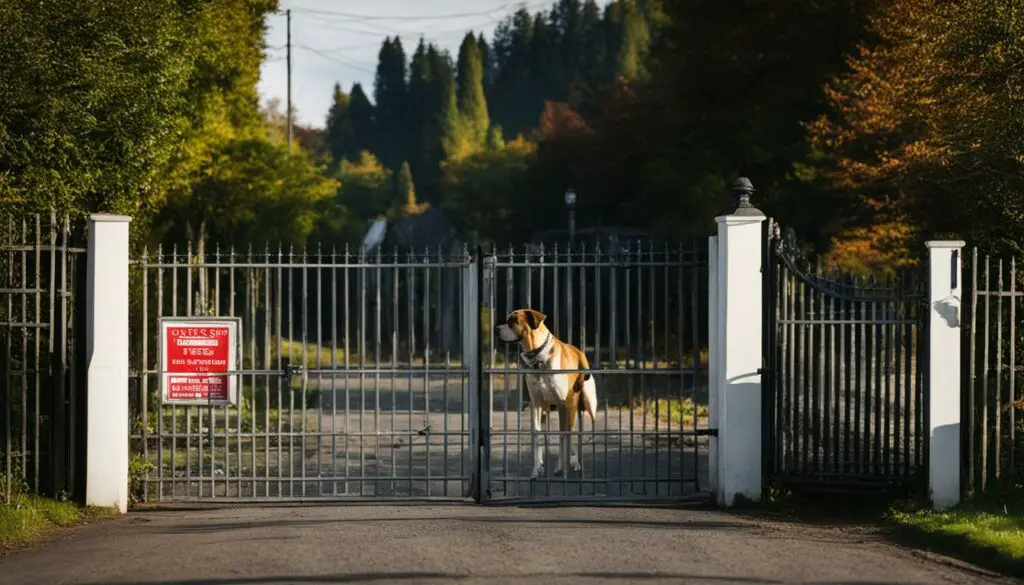Being approached by a loose dog can be a stressful and potentially dangerous situation, especially if you or your dog are vulnerable or reactive. It’s important to have strategies in place to handle these encounters and ensure the safety of everyone involved.
Key Takeaways:
- Avoid loose dog encounters by changing your walking route if you know certain areas have loose dogs.
- Stay alert and aware of your surroundings to spot loose dogs early and change direction if necessary.
- Use calming signals to defuse tense situations, such as avoiding direct eye contact and yawning.
- Employ a body block technique to protect your dog if a loose dog approaches.
- Communicate with the dog owner if you frequently encounter a loose dog in your neighborhood, politely asking them to contain their dog.
In conclusion, dealing with loose dogs in your neighborhood requires careful management to ensure the safety of all involved. By avoiding potential encounters, being aware of your surroundings, remaining calm, and taking appropriate actions, you can handle these situations responsibly. Remember to understand your legal rights in case of a dog bite and consult with a lawyer if necessary. The well-being of yourself, your dog, and the community should always be prioritized when dealing with loose dogs.
Avoid the Situation
When it comes to dealing with loose dogs in your neighborhood, one of the best strategies is to avoid the situation altogether. By changing your walking route, you can minimize the chances of encountering loose dogs and ensure the safety of both you and your dog. It’s important to be aware of certain houses or areas where dogs are frequently loose and choose a different path for your walks.
By opting for a different neighborhood or park where loose dog encounters are less likely, you can create a more peaceful and stress-free walking experience for you and your furry friend. This approach especially benefits dogs that are reactive or sensitive to interactions with loose dogs. It’s unfair to expect a leashed dog to tolerate such encounters, so changing your route can help prevent any potential conflicts.
To further enhance your safety, consider driving to a different neighborhood or park where encounters with loose dogs are less common. This will give you greater control over the environment and minimize the risk of unexpected encounters with loose dogs. Remember, prevention is key when it comes to dealing with loose dogs, and avoiding the situation altogether can save you from stressful and potentially dangerous situations.
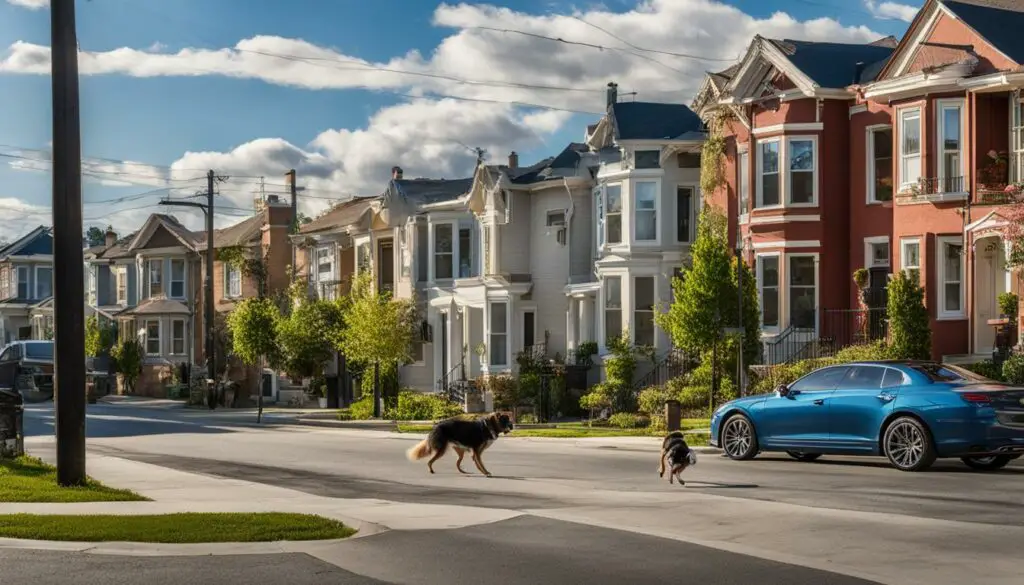
Benefits of Changing Walking Routes:
- Minimizes the chances of encountering loose dogs
- Ensures the safety of both you and your dog
- Reduces stress and anxiety for both you and your dog
- Allows for a more peaceful and enjoyable walking experience
- Prevents potential conflicts and ensures a positive interaction for reactive or sensitive dogs
By choosing to avoid the situations where loose dogs are present, you can create a safer and more enjoyable walking routine for you and your furry companion. Remember to always prioritize your safety and the well-being of your dog, and don’t hesitate to change your walking route if it means avoiding potential encounters with loose dogs.
Pay Attention to Your Surroundings
When walking in your neighborhood, it’s important to stay aware of your surroundings to spot any loose dogs that may be approaching. By being vigilant and proactive, you can quickly change direction and avoid potential encounters. This is especially crucial if you know that there are loose dogs in the area.
If you see a loose dog approaching, act calmly and swiftly. Change your direction and instruct your dog to turn with you. Using a favorite toy or treats can help redirect your dog’s attention away from the approaching dog.
Remaining alert and responsive will allow you to take control of the situation and keep yourself and your dog safe. Remember, the earlier you spot a loose dog, the easier it is to adjust your walk and avoid any potential conflicts.
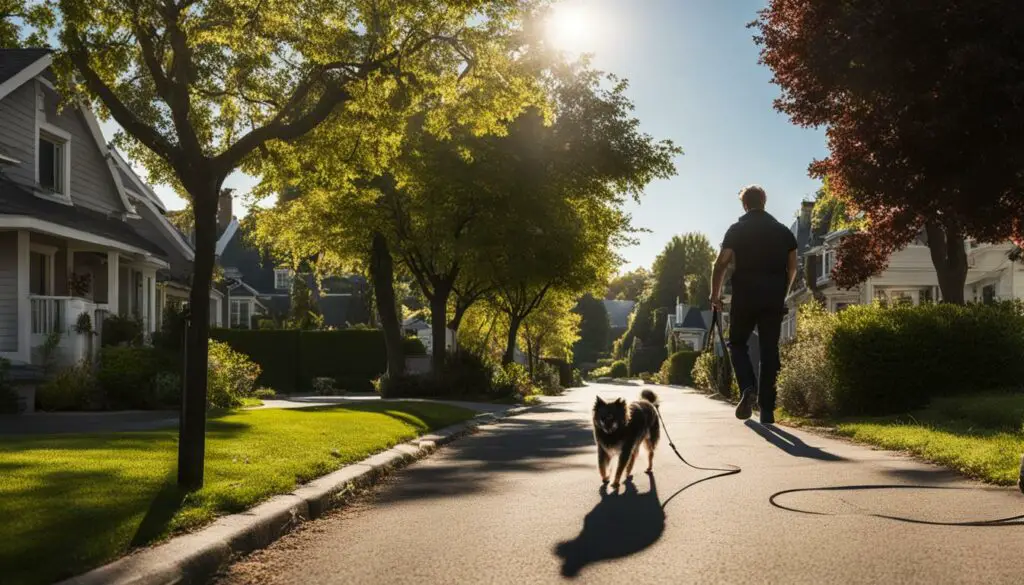
Table: Tips for Spotting and Avoiding Loose Dogs
| Tip | Description |
|---|---|
| Stay alert | Keep your eyes and ears open for any signs of loose dogs in your vicinity. |
| Know your neighborhood | Be aware of areas where loose dogs are frequently spotted and adjust your walking route accordingly. |
| Change direction | If you spot a loose dog approaching, quickly change your direction and calmly instruct your dog to turn as well. |
| Redirect attention | Use favorite toys or treats to redirect your dog’s attention away from the loose dog. |
“Being aware of your surroundings and acting quickly can prevent potential conflicts with loose dogs in your neighborhood.” – Dog Walker
Remain Calm and Use Calming Signals
When faced with an unwanted interaction with a loose dog, it’s crucial to stay calm and use calming signals to diffuse the situation and avoid potential conflicts. Calming signals are subtle behaviors that can help communicate non-threatening intentions to the dog.
Some examples of calming signals include:
- Avoiding direct eye contact with the dog
- Yawning
- Lip-licking
- Sniffing the ground
By employing these signals, you are effectively conveying that you pose no threat and are not initiating any aggressive behavior. This can help de-escalate tension and create a safer environment for both you and the loose dog.
“Calming signals can be powerful tools in avoiding conflict with loose dogs. By using these subtle behaviors, we can establish a peaceful atmosphere and reduce the risk of any aggressive reactions.”
Additionally, it’s important to use a calm and commanding tone of voice when addressing both the loose dog and your own dog. This can help maintain control of the situation and minimize any chances of escalating the interaction.
| Calming Signals | Benefits |
|---|---|
| Avoiding direct eye contact | Reduces perceived threat |
| Yawning | Signals non-aggression |
| Lip-licking | Indicates non-threatening intentions |
| Sniffing the ground | Shows non-hostile behavior |

By remaining calm and using calming signals, you can effectively navigate unwanted interactions with loose dogs and avoid potential conflicts. These strategies offer a non-threatening approach and prioritize the safety and well-being of everyone involved.
Body Block
When a loose dog is approaching your dog, one effective technique to protect your furry friend is to use a body block. This involves positioning yourself between the loose dog and your dog, using your body as a physical barrier. By doing so, you create a barrier that prevents the loose dog from reaching your dog, giving you better control of the situation.
The body block technique can be particularly useful if the loose dog is displaying aggressive behavior or if your dog is reactive and easily provoked. By stepping in and physically blocking the loose dog’s path, you can prevent any potential physical or emotional harm to your dog.
Table: Comparison of Body Block Technique and Other Methods
| Body Block Technique | Alternative Methods | |
|---|---|---|
| Effectiveness | High | Variable |
| Physical Protection | Provides a physical barrier between the loose dog and your dog, minimizing the risk of physical harm. | Relies on other methods of avoidance or distraction, which may not always be as effective in physically protecting your dog. |
| Control | Allows you to maintain control of the situation by positioning yourself between the loose dog and your dog. | Relies on the actions or behaviors of the loose dog or your dog, which can be unpredictable. |
| Emotional Support | Can provide emotional support to your dog by creating a physical barrier and signaling that you are there to protect them. | May not provide the same level of emotional support or reassurance to your dog. |
“The body block technique is a valuable tool in keeping your dog safe from approaching loose dogs. By acting as a physical barrier, it allows you to assert control over the situation and protect your dog from potential harm.” – Dog Training Expert
It’s important to note that the body block technique should only be used when you feel confident in your ability to handle the situation safely. If you are unsure or feel unsafe, it is best to seek assistance from a professional dog trainer or animal control for guidance.
Remember, the safety and well-being of your dog should always be your top priority. By utilizing strategies like the body block technique, you can effectively protect your dog from loose dogs in your neighborhood.
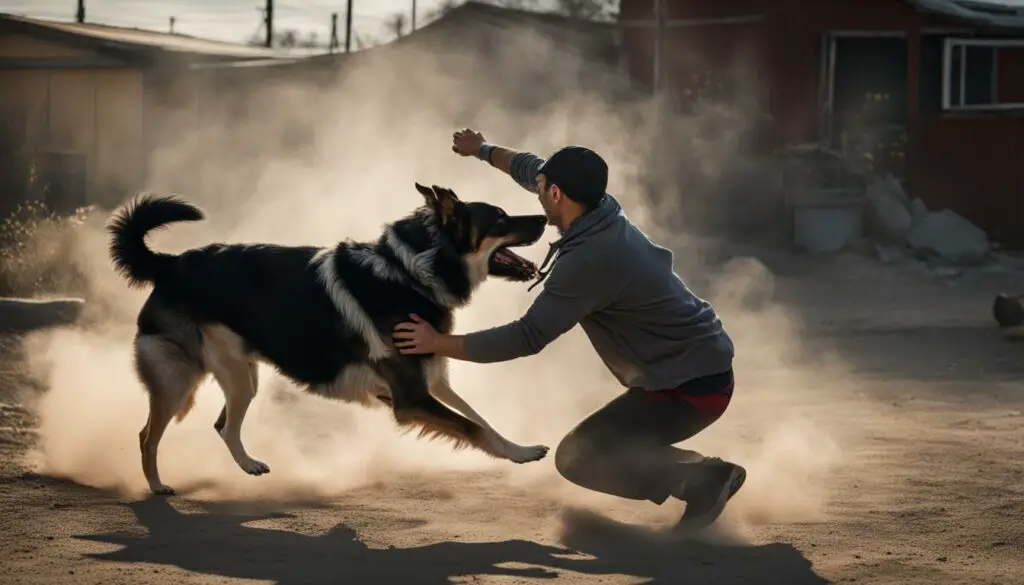
Communicate with the Dog Owner
When dealing with loose dogs in your neighborhood, one of the strategies you can employ is to communicate with the dog owner directly. By politely and kindly addressing the issue with them, you can help ensure the safety of everyone in the community. When talking to the dog owner, it’s important to maintain a friendly and non-confrontational approach.
You can start the conversation by complimenting their dog, which can help establish a positive tone. Then, explain the concerns about loose dogs and highlight the potential risks, such as the risk of the dog getting hit by a car or causing harm to someone. Politely ask them to contain their dog within their property or use appropriate restraints when taking it for a walk.
If the situation persists and the dog owner doesn’t take appropriate action, it may be necessary to report the loose dog to animal control or local authorities. They can intervene and enforce the necessary measures to ensure the safety of the neighborhood.
Table: Tips for Talking to Dog Owners
| Tip | Description |
|---|---|
| Be friendly and non-confrontational | Approach the conversation with a positive and calm demeanor to encourage a productive dialogue. |
| Compliment their dog | Start the conversation on a positive note by acknowledging something positive about their dog. |
| Explain the concerns | Clearly communicate the potential risks and hazards posed by loose dogs in the neighborhood. |
| Ask for containment | Promptly address the issue by asking the dog owner to contain their dog within their property or use appropriate restraints. |
| Report to local authorities if necessary | If the dog owner fails to take appropriate action, report the situation to animal control or local authorities for further intervention. |
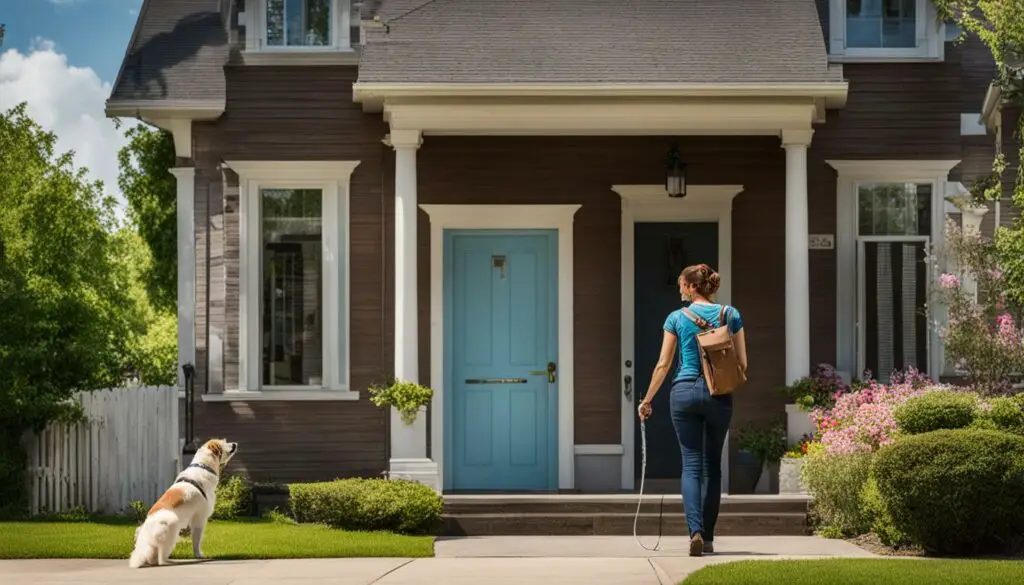
By engaging in respectful communication with dog owners, you can contribute to a safer and more harmonious neighborhood. Remember, it’s crucial to prioritize the well-being of both humans and animals when addressing the issue of loose dogs in your community.
Reporting a Loose Dog
If you encounter a loose dog in your neighborhood and all other attempts to resolve the situation have failed, it may be necessary to report the issue to animal control. By involving the appropriate authorities, you can ensure that the loose dog is properly addressed and the safety of the community is prioritized.
When reporting a loose dog, provide as much detail as possible to animal control. This includes the description of the dog, such as breed, size, color, and any distinguishing markings. If you know the address or location where the dog is frequently seen, be sure to provide that information as well. The more accurate and specific your report, the better equipped animal control will be to take appropriate action.
Reporting a loose dog to animal control not only helps protect your neighborhood, but it also assists in maintaining the well-being of the loose dog themselves. Animal control may be able to identify the owner and take steps to ensure that the dog is properly contained and cared for. By involving the authorities, you are contributing to the overall safety and welfare of both the community and the loose dog.
| Benefits of Reporting a Loose Dog to Animal Control |
|---|
| Ensures the safety of the community |
| Helps in identifying and addressing the dog’s owner |
| Contributes to the well-being of the loose dog |
| Supports the efforts of animal control in maintaining order |
Remember, reporting a loose dog to animal control should be done after you have exhausted other options and have concerns about the safety of yourself, your dog, and the community. By taking this step, you are actively working towards a resolution and helping to create a safer environment for everyone involved.
Premises Liability and Dog Owner Responsibility
When dealing with a loose dog, it’s important to understand premises liability and the responsibility that falls on the dog owner. Premises liability refers to the legal concept that holds property owners responsible for any injuries or damages that occur on their premises. In the case of a loose dog in a neighborhood, the dog owner can be held liable for any injuries caused by their dog, regardless of the dog’s prior behavior.
While dog owners are generally responsible for their dog’s actions, there may be exceptions if the victim was trespassing or provoking the dog. It’s important to consult a legal professional to understand your rights and options if you have been bitten or injured by a loose dog. They can help determine if the dog owner is liable for your injuries and guide you through the legal process.
Premises liability holds dog owners responsible for any injuries caused by their dogs, regardless of the dog’s prior behavior.
Understanding premises liability is essential for both dog owners and those who may encounter loose dogs in their neighborhood. By holding dog owners accountable, it promotes responsible pet ownership and helps ensure the safety of the community.
| Responsibility | Description |
|---|---|
| Dog Owner | The dog owner is responsible for preventing their dog from being loose and causing harm to others. |
| Property Owner | The property owner may also be held responsible if they were aware of the loose dog and failed to take appropriate actions to prevent injuries. |
| Victim | The victim has a responsibility to take necessary measures to avoid the loose dog and prevent potential harm. |
By understanding the concept of premises liability and dog owner responsibility, individuals can protect themselves and their community when encountering loose dogs.
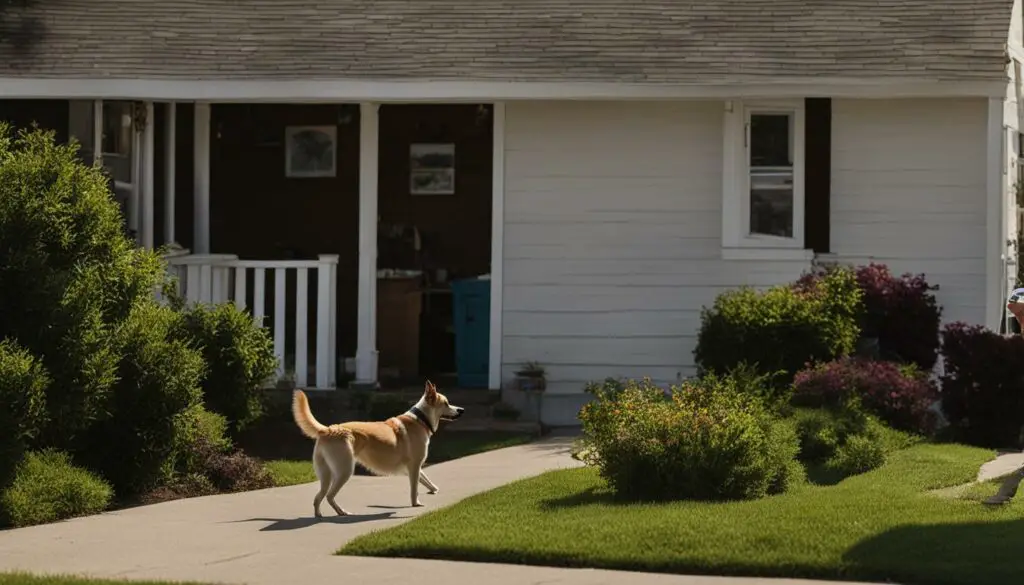
Immediate Actions After a Dog Bite
If you or someone you know has been bitten by a dog, it’s crucial to take immediate actions to protect your health and legal rights. The first and most important step is to seek medical attention. Even minor dog bites can lead to serious infections, so it’s essential to have a healthcare professional evaluate the wound and provide appropriate treatment. Remember to save all medical records and bills related to your treatment, as they may be important evidence for your case.
While you’re waiting for medical help to arrive or on your way to the hospital, it’s also essential to document the incident. Take photographs of the injuries as soon as possible. These photos will help provide visual evidence of the severity of the bite. Additionally, gather information about the dog and its owner, including their names, addresses, and contact information. If there were any witnesses to the incident, try to obtain their names and contact details as well. This information will be valuable when filing a report or pursuing legal action.
After seeking medical attention and documenting the incident, it’s crucial to consult with a qualified attorney who specializes in dog bite cases. A knowledgeable lawyer can evaluate the specific circumstances of your case and advise you on your legal rights and options. They can guide you through the claims process, help gather additional evidence, negotiate with insurance companies, and represent you in court if necessary. An experienced attorney will ensure that you receive the compensation you deserve for your injuries, medical expenses, and other damages.
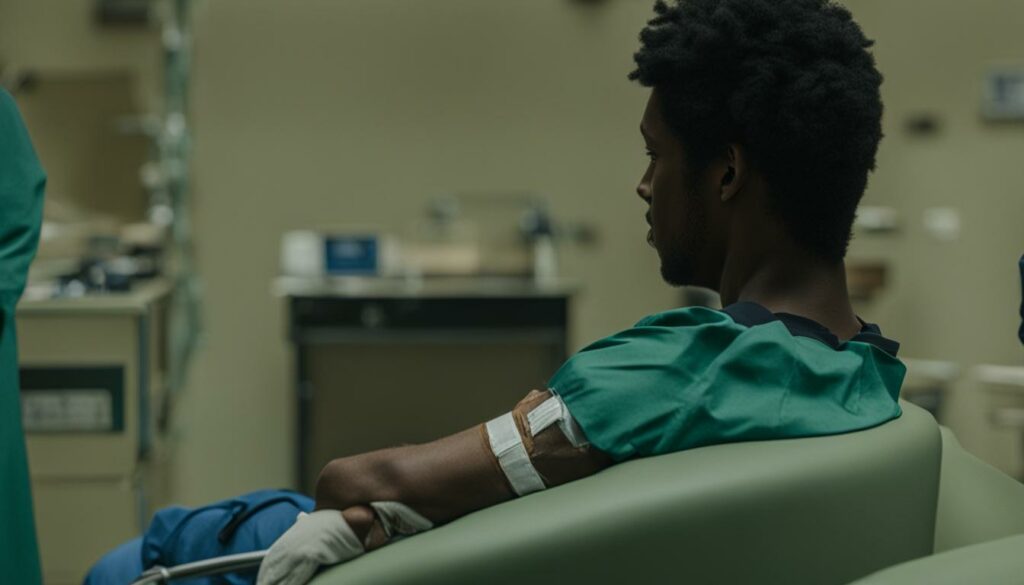
| Immediate Actions After a Dog Bite | Summary |
|---|---|
| Seek medical attention | Visit a healthcare professional to evaluate the wound and provide appropriate treatment |
| Document the incident | Take photographs of the injuries and gather information about the dog and its owner |
| Consult with a dog bite lawyer | Seek legal representation to navigate the claims process and pursue compensation |
“Seeking immediate medical attention and documenting the incident are crucial steps after a dog bite. Consulting with a knowledgeable attorney is also essential to protect your legal rights and pursue the compensation you deserve.”
Liability for Dog Bite Injuries in Florida
In the state of Florida, dog owners are typically held liable for injuries caused by their dogs. Florida follows strict liability laws when it comes to dog bites, which means that the owner is responsible for any injuries the dog inflicts, regardless of the dog’s previous behavior or the owner’s knowledge of its aggressiveness. This strict liability applies as long as the victim was in a public place or lawfully present in a private place, including the dog owner’s property.
It’s important to note that there are exceptions to this strict liability rule. If the victim was trespassing or provoking the dog, the dog owner may not be held fully responsible for the resulting injuries. However, even in these cases, the dog owner may still be partially liable depending on the circumstances. Consulting with a dog bite lawyer is crucial to evaluate the specific circumstances of your case and determine the extent of the dog owner’s liability.
It is important to understand that the strict liability laws in Florida regarding dog bite injuries can greatly benefit victims. You may be entitled to compensation for medical expenses, lost wages, pain and suffering, and other damages resulting from the dog bite. By consulting with a knowledgeable attorney who specializes in dog bite cases, you can navigate the legal process and pursue the compensation you deserve.
| Key Points | Details |
|---|---|
| Law Applies To | Florida |
| Liability Type | Strict Liability |
| Exceptions | Trespassing or Provoking the Dog |
| Compensation | Medical Expenses, Lost Wages, Pain and Suffering, Other Damages |
Compensation in Dog Bite Cases
In cases where a dog bite occurs and causes injuries, victims may be entitled to compensation for their damages and losses. Compensation can help cover various aspects, including medical expenses, lost wages, pain and suffering, emotional distress, and even scarring or disfigurement resulting from the attack. It is important for victims to understand their rights and seek appropriate compensation for the harm they have endured.
When it comes to medical expenses, victims may be reimbursed for all necessary treatments and procedures related to their injuries. This can include hospital stays, surgeries, medications, rehabilitation, and any ongoing medical care required for recovery. Additionally, compensation can also factor in the cost of future medical treatments if the injuries result in long-term or permanent effects.
Emotional distress is another significant aspect of compensation in dog bite cases. Being attacked by a dog can cause intense emotional trauma, leading to anxiety, depression, post-traumatic stress disorder (PTSD), or other psychological disorders. Compensation can provide financial support to cover therapy sessions, counseling, and other mental health treatments necessary to address the emotional impact of the incident.
| Types of Compensation | Description |
|---|---|
| Medical expenses | Covers costs related to medical treatments and future care |
| Lost wages | Compensates for income lost due to time off work during recovery |
| Pain and suffering | Provides financial support for physical and emotional pain endured |
| Emotional distress | Covers mental health treatments for psychological impact |
| Scarring or disfigurement | Compensation for permanent physical changes resulting from the attack |
It is essential for dog bite victims to consult with a knowledgeable attorney who specializes in this area of law. A dog bite lawyer can assess the specific circumstances of the case, gather evidence, and determine an appropriate compensation amount to pursue. They will advocate for the victim’s rights and negotiate with the dog owner’s insurance company to seek a fair settlement. If necessary, they can also take the case to court to ensure the victim receives the compensation they are entitled to.

Statute of Limitations for Dog Bite Lawsuits in Florida
When it comes to filing a dog bite lawsuit in Florida, it’s important to be aware of the statute of limitations. This is the time frame within which you must initiate legal action, or else your claim may be barred. In Florida, the statute of limitations for dog bite lawsuits is generally four years from the date of the incident.
It’s crucial to take prompt action if you’ve been bitten by a dog and intend to seek compensation for your injuries. The statute of limitations is in place to ensure that legal matters are resolved in a timely manner. By adhering to this time limit, you preserve your right to pursue a lawsuit and hold the responsible parties accountable.
The statute of limitations for dog bite lawsuits in Florida is four years from the date of the incident.
Consulting with a dog bite lawyer is essential if you’re considering filing a lawsuit. They can help you navigate the legal process, gather evidence, and ensure that your claim is filed within the required time frame. They will also guide you through the complexities of the legal system and work to maximize the compensation you may be entitled to.
Remember, each case is unique, and there may be exceptions or specific circumstances that could affect the statute of limitations. It’s always best to consult with a legal professional who specializes in dog bite cases to ensure you have the most accurate and up-to-date information.
| Statute of Limitations for Dog Bite Lawsuits in Florida | |
|---|---|
| Time Limit | Four years from the date of the incident |
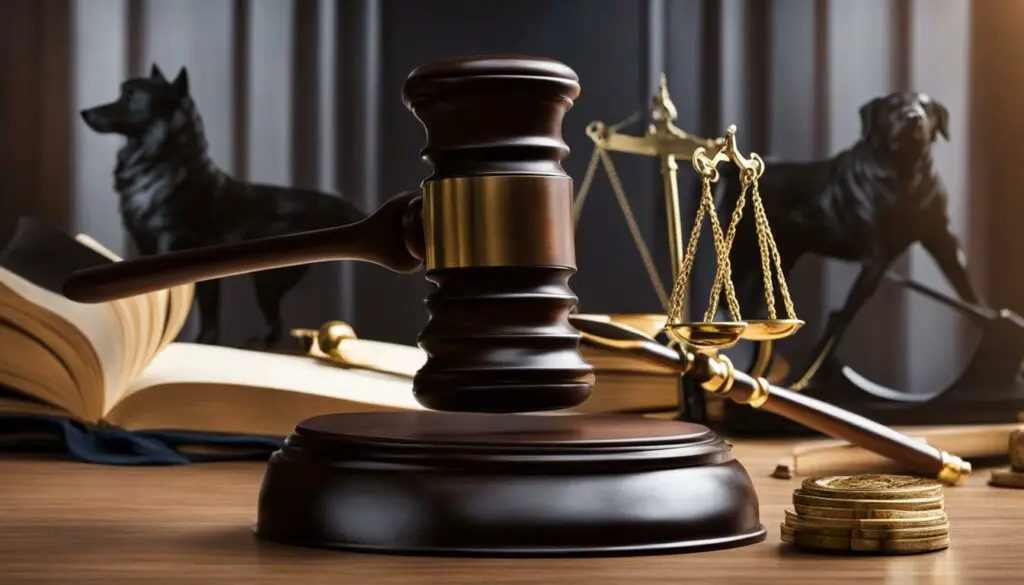
Understanding the Statute of Limitations
The statute of limitations is a legal concept that sets the maximum time period within which a claim can be filed. It encourages parties to bring forward their claims in a timely manner, ensuring that evidence and witnesses are still available and that the legal process can proceed efficiently.
In the context of dog bite lawsuits in Florida, the four-year statute of limitations provides victims with a reasonable amount of time to initiate legal action. It is important to adhere to this time limit to avoid losing the opportunity to seek compensation for your injuries.
Consulting with a dog bite lawyer is crucial in determining the specific time frame for your case and understanding any exceptions or circumstances that may affect the statute of limitations. They can provide you with personalized guidance and support throughout the legal process, ensuring that your rights are protected.
How a Dog Bite Lawyer Can Help You
If you or a loved one has been bitten by a dog, seeking the assistance of a dog bite lawyer is crucial in understanding your legal rights and pursuing compensation. A dog bite lawyer specializes in handling cases related to dog attacks and can provide invaluable support throughout the legal process.
One of the key roles of a dog bite lawyer is gathering evidence to strengthen your case. They will work closely with you to collect medical records, photographs of your injuries, and witness statements to build a strong foundation for your claim. By presenting compelling evidence, a lawyer can help establish liability and hold the dog owner accountable for their negligence.
Furthermore, a dog bite lawyer will negotiate with the dog owner’s insurance company on your behalf. Insurance companies often try to minimize settlements or deny claims altogether, but a skilled lawyer will fight for your rights and seek a fair and just settlement. If negotiations are unsuccessful, a lawyer can take your case to court and litigate on your behalf.

It’s important to remember that each dog bite case is unique, and the compensation you may be entitled to will depend on various factors such as the severity of your injuries, the emotional distress caused, and any long-term effects. A dog bite lawyer will assess the specifics of your case and work diligently to help you recover the compensation you deserve.
Conclusion
Dealing with loose dogs in your neighborhood can be a challenging and potentially dangerous situation. It’s important to have strategies in place to handle these encounters and ensure the safety of everyone involved, including yourself and your dog. By following some key tips and being aware of your legal rights, you can effectively manage loose dog situations.
First and foremost, avoiding loose dog encounters whenever possible is the best approach. If you know certain areas where dogs are frequently loose, consider changing your walking route to minimize the risk. This can help prevent potential confrontations, especially if your dog is reactive or sensitive.
When faced with a loose dog, it’s crucial to remain calm and use calming signals to defuse tense situations. Avoid direct eye contact, yawn, lip-lick, and sniff the ground to communicate non-aggressiveness to the loose dog. Simultaneously, use a calm and commanding tone of voice when addressing both the loose dog and your own dog.
If a loose dog approaches, you can protect your dog by using a body block technique. Position yourself between the loose dog and your dog, using your body as a physical barrier. This can help prevent the loose dog from reaching your dog and give you more control over the situation.
Understanding your legal rights after a dog bite is also crucial. If you or someone you know is bitten by a dog, seek immediate medical attention and document the incident. Consult with a qualified attorney to understand your legal options and pursue compensation for your injuries, if applicable.
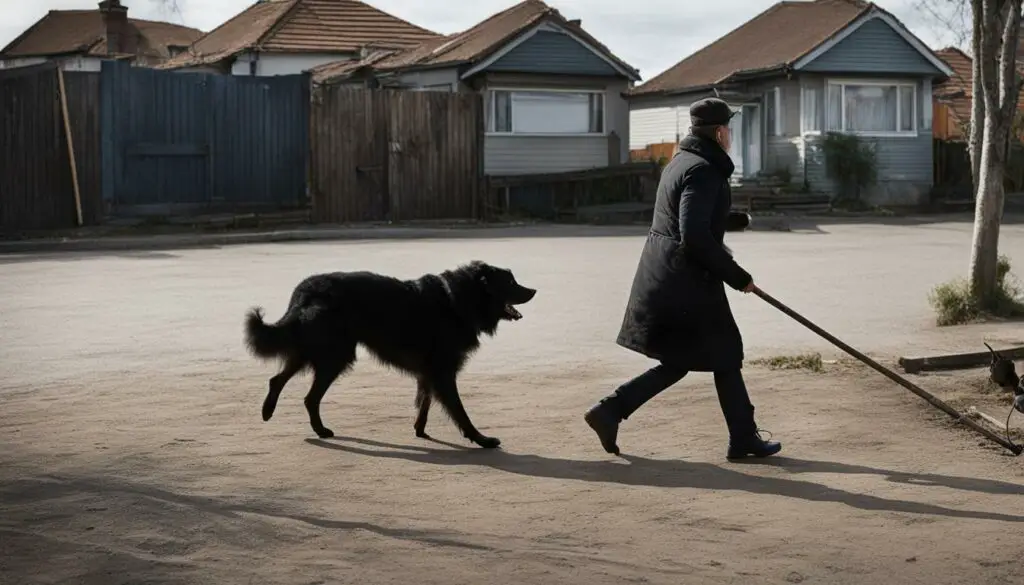
Table: Tips for Handling Loose Dogs
| Tips | Description |
|---|---|
| Avoid the situation | Choose alternate walking routes to avoid areas with frequently loose dogs. |
| Pay attention to surroundings | Be alert and change direction if you spot a loose dog approaching. |
| Remain calm and use calming signals | Avoid direct eye contact and use non-threatening behaviors to communicate. |
| Body block | Position yourself between the loose dog and your dog to create a physical barrier. |
| Communicate with the dog owner | Politely ask the dog owner to contain their dog for the safety of everyone. |
| Reporting a loose dog | If necessary, report the loose dog to animal control or local authorities. |
| Premises liability | Understand the dog owner’s responsibility for any injuries caused by their dog. |
| Immediate actions after a dog bite | Seek medical attention and document the incident for legal purposes. |
| Dog bite liability in Florida | Know the strict liability laws in Florida regarding dog bite injuries. |
| Compensation in dog bite cases | Explore potential compensation for medical expenses, pain and suffering, and more. |
Summary:
Dealing with loose dogs requires caution and preparedness. By avoiding encounters, staying calm, and using protective techniques, you can prioritize safety for yourself and your dog. It’s essential to understand your legal rights in case of a dog bite and consult with a dog bite lawyer if necessary. Remember, responsible handling of loose dogs ensures a safer neighborhood for everyone.
Conclusion
Dealing with a loose dog in your neighborhood can be a challenging and potentially dangerous situation. However, by taking the right steps, you can handle these encounters responsibly and ensure the safety of yourself, your dog, and the community.
First and foremost, it’s important to understand that dog owners have a responsibility to keep their dogs properly contained. If you frequently encounter loose dogs in your neighborhood, consider speaking with the dog owner directly and politely asking them to contain their dog. By addressing the issue in a friendly manner, you can help prevent future incidents from occurring.
When faced with a loose dog, it’s crucial to remain calm and use the strategies outlined in this article. Avoiding the situation whenever possible, paying attention to your surroundings, and using calming signals can help defuse tense situations and avoid conflicts. Additionally, if necessary, use a body block technique to protect your dog from approaching loose dogs.
If you or someone you know has been bitten by a dog, it’s important to understand your legal rights. Dog owners are typically held liable for injuries caused by their dogs, and you may be entitled to compensation for your injuries. Consult with a dog bite lawyer to evaluate your specific case and ensure you receive the compensation you deserve.
FAQ
What should I do if I encounter a loose dog in my neighborhood?
It’s best to avoid the situation if possible by choosing a different walking route or driving to a different area. If you do encounter a loose dog, quickly change direction and calmly redirect your dog’s attention away from the loose dog.
How can I stay alert and avoid potential encounters with loose dogs?
Pay attention to your surroundings, especially if you know there are loose dogs in the area. Spotting a loose dog early allows you to adjust your walk and avoid a potential encounter by changing direction.
What are calming signals and how can they help in interactions with loose dogs?
Calming signals include avoiding direct eye contact, yawning, lip-licking, and sniffing the ground. Using these signals can help defuse tense situations and avoid potential conflicts with loose dogs.
How can I protect my dog from a loose dog approaching?
You can use a body block technique by positioning yourself between the loose dog and your dog, using your body as a physical barrier. This can help prevent the loose dog from reaching your dog and give you better control of the situation.
What should I do if I frequently encounter a loose dog in my neighborhood?
If possible, speak to the dog owner directly and politely ask them to contain their dog for everyone’s safety. Complimenting their dog and explaining the risks of loose dogs can help. If necessary, report the loose dog to animal control or local authorities.
What are the legal responsibilities of dog owners for injuries caused by their dogs?
In most cases, dog owners are held responsible for injuries caused by their dogs, regardless of the dog’s prior behavior. However, there may be exceptions if the victim was trespassing or provoking the dog. Consult a legal professional to understand your rights and options.
What immediate actions should I take if I or someone I know has been bitten by a dog?
Seek medical attention as soon as possible, even for minor bites. Document the incident by taking photographs of the injuries and gathering information about the dog and its owner. Consult with a qualified attorney to understand your legal options.
What are the liability laws for dog bite injuries in Florida?
In Florida, dog owners are typically held liable for injuries caused by their dogs. The state follows strict liability laws, meaning owners are responsible regardless of the dog’s previous behavior or the owner’s knowledge of its aggressiveness.
What compensation can I receive in a dog bite case?
Dog bite victims may be entitled to compensation for medical expenses, lost wages, pain and suffering, emotional distress, and scarring/disfigurement resulting from the attack. The specific compensation depends on the severity of the injuries and other factors.
Is there a time limit for filing a dog bite lawsuit in Florida?
Yes, there is a four-year statute of limitations from the date of the dog bite to initiate legal action. Failing to file within this time frame may result in your claim being barred. Consult a dog bite lawyer to ensure you comply with the time limits.
How can a lawyer help with my dog bite case?
A dog bite lawyer can help gather evidence, negotiate with the dog owner’s insurance company, and litigate your case if necessary. They provide legal support and guidance throughout the process to help you pursue the compensation you deserve.

